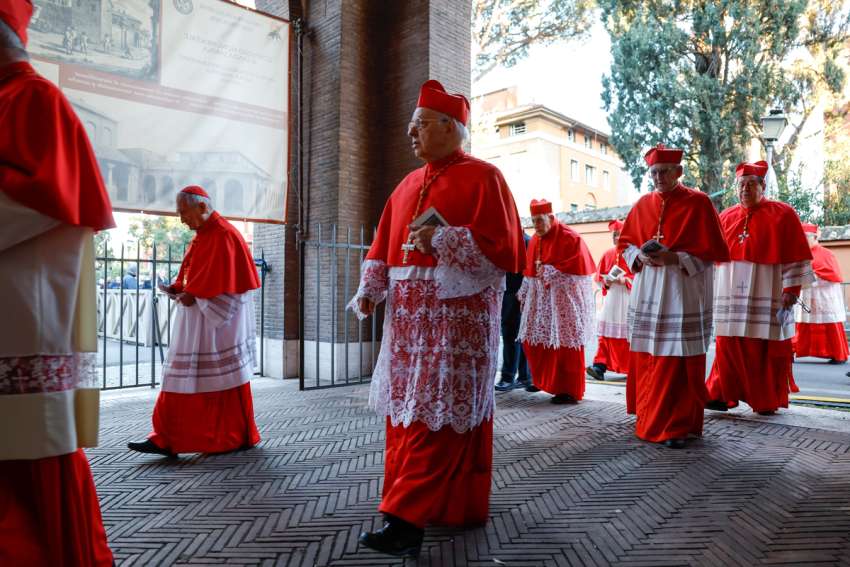The pope announced Oct. 6 that he would create 21 new cardinals Dec. 8; fully 20 of the men named are under the age of 80 and would be eligible to enter a conclave to elect a pope.
With one current member of the College of Cardinals -- Venezuelan Cardinal Baltazar Porras Cardozo of Caracas -- about to celebrate his 80th birthday, when the new cardinals are inducted into the college in December, there could be as many as 141 "cardinal electors."
The previous record, set by Pope Francis in 2023, was 137 cardinal electors.
St. Paul VI in 1975 ruled that there should not be more than 120 cardinal electors at any one time. St. John Paul II, Pope Benedict XVI and now Pope Francis regularly exceeded that limit -- but usually only by a few cardinals and only for a short time.
With Pope Francis' new nominations, the college could exceed the limit of 120 cardinal electors well into 2026.
The consistory to create new cardinals in December will be the 10th time Pope Francis has distributed red hats since his election in March 2013.
As the names were announced, nine of the new cardinals were in Rome as participants in the Synod of Bishops on synodality.
One of the cardinals-designate, Bishop Mykola Bychok of the Ukrainian Eparchy of Sts. Peter and Paul of Melbourne, Australia, is only 44 years old and will be the youngest member of the college by six years. His nomination and that of six new cardinals in their 50s has nudged the average age of the electors down.
As of Oct. 6, without the new cardinals, the average age of the 122 prelates eligible to enter a conclave was 71 years, seven months and 10 days; with the new members on Dec. 8, if no one dies, the average age of the group of electors will be 70 years and five months.
Some pundits like to talk about Pope Francis "stacking the deck" by supposedly appointing like-minded cardinals to choose the next pope; the information is pointed out usually as an accusation hinting that the electors are all "liberal" in one sense or another.
It's true that if a conclave were held Dec. 9 and no cardinal elector dies before then, almost 79% of the cardinals entering the Sistine Chapel would be clerics given their red hats by Pope Francis. But it is also true that 100% of the cardinals who entered the conclave in 2013 were named cardinals by St. John Paul II or Pope Benedict XVI and they elected Pope Francis.
People often speak of Pope Francis going to the "peripheries" for the bishops and archbishops he chooses as cardinals. And he did the same this time. For example, Belgium-born Archbishop Dominique Joseph Mathieu of Tehran and Isfahan, Iran, is the first head of an Iranian diocese to be made a cardinal.
But the pope also put six countries that have had cardinal electors back on the list by naming archbishops ministering in or born in Algeria, Australia, Ecuador, Lithuania, Peru and Serbia. The number climbs to seven countries if Cardinal-designate Bychok is counted twice: once for being born in Ukraine, which currently does not have a cardinal, and once for ministering in Australia, which has not had a cardinal elector since the late Cardinal George Pell turned 80 in 2021.
Therefore, after the consistory in December, more than 70 nations will be represented among the cardinal electors. In the 2013 conclave that elected Pope Francis, the 115 cardinals who entered the Sistine Chapel to vote came from 48 countries.
Pope Francis' choices over time also have ended the European dominance of electors in the College of Cardinals. Even before his new picks receive their red hats, only 40% of the current cardinal electors are European, according to a table kept by the Vatican press office. The addition of the 20 new electors will drop that percentage to just over 38%.
The percentage of cardinal electors from Asia will rise to just over 19%. Latin Americans follow with 17% and Africans will make up close to 13% of the electors. The 14 cardinals from the United States and Canada who are under 80 make up about 10% of the electors and the four from Oceania represent just under 3%.
More than half of the 21 cardinals named by Pope Francis Oct. 6 are members of religious orders, which will bring to 70 the number of the world's cardinals who trained and ministered as members of religious communities or congregations. Although neither order will have new cardinals, the Salesians will still lead the list with 11 cardinals, followed by the Jesuits with nine.
Friars following St. Francis of Assisi would lead the list, but they are divided into three families: The Friars Minor will have five members; the Capuchins will have five members; and the Conventual Franciscans will have three.


